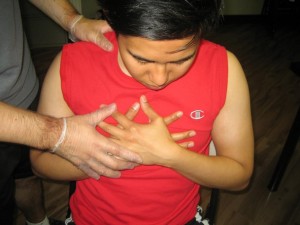Angina is often a symptom of an underlying heart problem and is not a disease in itself. It is defined as the feeling of chest pain or discomfort that is due to the lack of oxygen-rich blood reaching the muscles of the heart. The feeling may be present only the chest but can also radiate to the neck, jaw, shoulders, arms and back.
Angina is commonly caused by buildup of plaque in the coronary arteries. Plaque buildup is caused by the aggregation of cholesterol and other fatty substances on the artery walls of the heart causing the artery to narrow. When the arteries narrow and stiffen, it causes insufficient amount of oxygen-rich blood to reach the muscles of the heart. Angina should not be confused with heart attack (myocardial infarction), as the latter refers to the permanent damage to the heart cells due to ischemia (low oxygen), the former pertains to the chest pain.
Each year, millions suffer from angina. It is most commonly related to coronary heart disease but can also manifest in other diseases such as aortic stenosis (narrowing of the aortic valve of the heart), aortic dissection (tearing of a major artery of the heart), cardiomyopathy, pericarditis, lung infection or pulmonary embolism.
Types of Angina
There are four types of angina that are differentiated based on their onset and symptoms.
Stable Angina
- Most common
- Has a usual pattern of regularity and severity
- Pain only lasts for several minutes
- Can be relieved by taking medications
- Warning sign for an impending heart attack
Unstable Angina
- May be fatal and requires immediate medical help
- When it happens is unpredictable
- May occur more frequently and more severe than stable angina
- May happen even with the absence of physical exertion
- Warning sign for an impending heart attack
Variant (Prinsmetal’s) angina
- Uncommon
- Caused by coronary artery spasm
- Severe pain that is not relieved by rest but can be relieved by medication
- Typically occurring between midnight and early morning
- Most severe
- Has the longest duration
- Not relieved by medication
Associated Symptoms of Angina
Angina is usually described as a sharp or dull pain, discomfort, tightness or ache in the chest. At times, associated symptoms may manifest with angina, such as:

- Referred pain in the neck, jaw, shoulders, arms or back
- Postprandial pain (after eating)
- Pain when bending
- Dizziness
- Breathlessness
- Fatigue
First Aid Measures for Angina
Apply first aid skills learned in First Aid Courses when assisting a patient suffering from angina. The following can help alleviate the symptoms of angina:
- If the person is engaged in any activity, stop immediately.
- Assist the person into a position of greatest comfort with the head elevated.
- Reassure the person
- If it is the first time or if the pain is bothersome, call for emergency medical services.
- If the person has medications for angina, assist the person in taking the medications.
- Monitor the person’s vital signs. If necessary, initiate CPR.
Angina, often a symptom for a heart problem, is feeling of chest pain or discomfort due to the lack of oxygen-rich blood flowing to the heart.